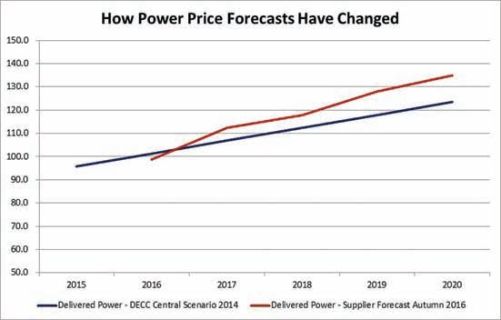Are We Sailing into a Perfect Storm For Energy Prices?

Believe it or not, UK industry has been enjoying a two-year cheap energy holiday, with costs for 1MWh of power and gas as low as £85-£15 for some. But that mini-era is coming to an end.
Goodbye to Fair Energy Waters
Consider these facts:
- With commodities priced in dollars, the low post-Brexit pound is already pushing up the cost of heat and power.
- The non-commodity costs of power are rising faster than inflation, and will surpass £55/MWh for many industrial users in the next 12 months.
- The closing gap between generation capacity and demand is driving further volatility. Prices spiked as high as £1,000/MWh in May 2016, even before Brexit.*
Indeed, most suppliers’ power price forecasts are now much worse than DECC’s last attempt in late 2014:
Tinkering at the edges isn’t going to solve this problem and it’s not just about getting a better deal out of your supplier. Riding out the energy price storm means using less energy.
Battening Down the Energy Hatches
First, get a mixed-discipline team together. Your engineers usually have an idea where the savings can be made, but they will need help to make the case. As a minimum, co-opt someone with commercial skills and the language and influence necessary to get investments and interventions signed off. A senior environmental person is also very useful as energy savings mean carbon savings, and that’s a good supporting story.
Second, it’s impossible to make a valid investment case without data. Collect an hourly picture of energy use for each major plant item throughout the year for the engineering team to analyse for usage and wastage, and calculate how much it will cost to put right.
When the team has identified where savings can be made and what the investment requirements are, then it can make the case for intervention.
In some cases the solution will be behavioural, such as turning off plant when production stops and optimising flow and temperature settings. In these cases employees will need to feel that adjusting settings will not compromise normal operations. And it helps to share the benefits that savings bring – even if only with praise.
Moving on to technical solutions, there are an increasing number of ‘plug and play’ fixes that are easy to install and have well-documented paybacks. Examples include LED lighting, boiler economisers and variable speed drives. The impact of any of these in isolation is relatively small. However, demonstrating successful payback is really effective in building confidence for more ambitious interventions.
Once some of these are in place, then larger energy saving projects can be considered. Combined Heat and Power (CHP), boiler house refits or ‘de-steaming’ will save the largest sums. BasePower’s own CHP technology is proven to save between 10-20% of the cost of energy supplied; for sites using over 1MW of power this can be a sizeable six-figure sum. The larger savings serve to justify the additional complexity and the need for third party expertise to interpret vendor sales pitches.
It looks like stormy energy waters are ahead for high-energy users in narrow margin industries such as food and drink manufacturing. Ask your electricity supplier for a five-year power price projection if you doubt it. Our advice is to get the team together and start looking at your energy use data now.
For more information contact Basepower on info@basepower.com or visit www.basepower.com.
*https://www.ft.com/content/0ac7d2e4-16b9-11e6-b197-a4af20d5575e


































